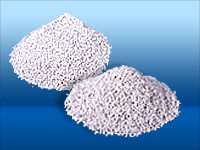Perlit / Perlite

Perlite belongs to the group of anorganic insulation materials, or more precisely to the mineral foam insulations. Perlite is a silicate stone of volcanic origin, which is why it is frequently known as volcano stone or obsidian. Due to its origin, we would refer to this stone as a natural glass from its chemical composition (alkali content 7-8%). The mineral name perlite came from the French mineralogist, François Sulpice Beudant, during his mineralogical tours around Hungary in the year 1818, due to the pearl-shaped structure.
Perlite has the property that it increases 20 times in volume when heated (in the blowing process). The reason for this is the crystal water contained in the raw perlite stone mix which vaporises when heated. This produces pumice-like products with extremely thin pore walls which can be processed into very valuable thermal insulation materials for construction.
Perlite is an environmentally-friendly product which can be returned to nature as a recyclable material.
Perlite is an important basic module in construction, industry, fire protection, gardening and animal care.
Typical chemical analysis:
| SiO2 | 60 - 80% |
|---|---|
| CaO | 0 - 2% |
| Al2O3 | 12 - 16% |
| MgO | 0 - 1% |
| TiO2 | 0 - 1% |
| Na2O | 5 - 10% |
| Fe2O3 | 0 - 1% |
| K2O | 2 - 5% |
Technical data
| Conductivity value λ | 0.050 W/(m*K) |
|---|---|
| Granulation | 0-6 mm |
| Bulk weight approx. | 85 kg/m³ +20% |
| Pure density | 2.0 - 2.2g/cm³ |
| Strength | 0.01MN/m² |
| Form | grain |
| Colour | white/grey-white |
| Annealing loss | < 1weight % |
| pH value | ~ 7 |
| Hygroscopic equilibriummoisture | < 1.5 weight % |
All details are average values from a larger number of analyses.





